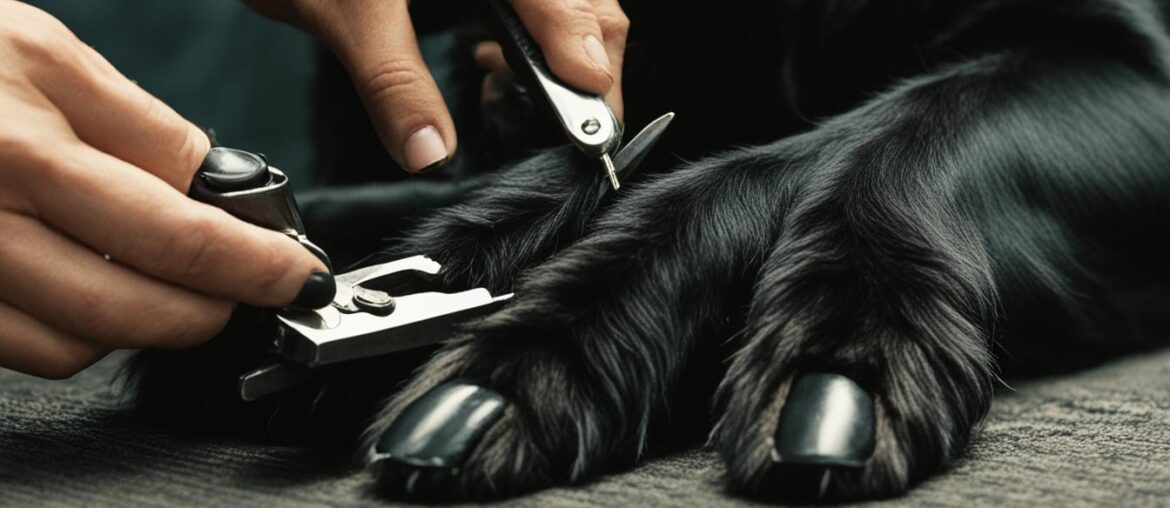Trimming dog nails is an essential part of dog grooming, but when it comes to black nails, many dog owners feel intimidated. The fear of cutting the quick, the sensitive part of the nail, can make the process daunting. However, with the right techniques and tools, cutting black dog nails can be done safely and effectively.
First, it’s important to understand the structure of a dog’s nail. A dog’s nail consists of a hard outer shell called the white horn, which surrounds the sensitive quick. In black nails, the quick is not easily visible, making it more challenging to determine its location.
Here are some key tips for cutting black dog nails:
- Acclimate your dog to paw handling and nail clippers before attempting to trim their nails. This helps reduce anxiety and stress during the process.
- Use dog nail trimmers specifically designed for dogs. Human nail trimmers are not suitable for cutting dog nails and may cause injury.
- Have styptic powder on hand in case of accidental cuts. Styptic powder helps stop bleeding if the quick is cut.
- Start with small increments when cutting black nails. Look for the appearance of the quick, a small black dot in the center of the white horn. Trim a little at a time and avoid cutting too close to the quick to prevent bleeding and pain.
- Take it slow and be mindful of your dog’s behavior. Reward positive behavior and stop if your dog becomes stressed or uncomfortable.
By following these tips, you can trim your dog’s black nails with confidence and keep their paws healthy.
Key Takeaways:
- Trimming black dog nails can be intimidating but with the right techniques and tools, it can be done safely and effectively.
- Acclimate your dog to paw handling and nail clippers to reduce anxiety during the process.
- Use dog nail trimmers designed for dogs and have styptic powder on hand in case of accidental cuts.
- Start with small increments when trimming black nails and avoid cutting too close to the quick to prevent bleeding.
- Take it slow, reward positive behavior, and stop if your dog becomes stressed or uncomfortable.
Why Trimming Black Dog Nails Can Be Challenging
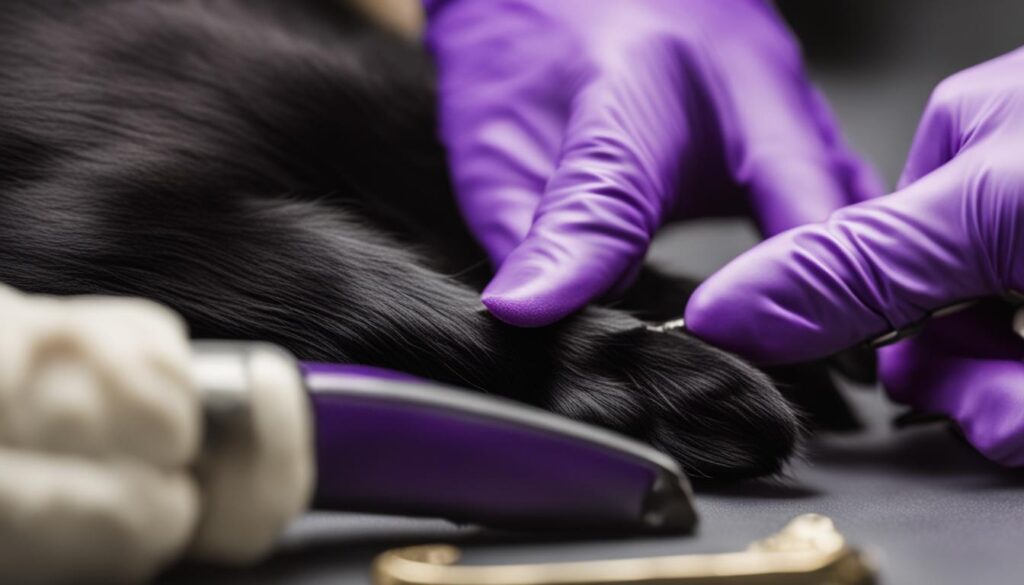
Trimming black dog nails can pose unique challenges due to the hidden nature of the quick, the sensitive part of the nail. Unlike white nails that have a visible pink quick, black nails require extra caution and attention during trimming. Cutting the quick can be painful and cause bleeding, so it’s essential to proceed slowly and with care when trimming black nails to ensure the safety and well-being of your pet.
To illustrate the difficulties with black dog nail trimming, imagine trying to trim a black nail without being able to clearly see the quick. It’s like navigating in the dark with the risk of accidentally cutting too close. The lack of visibility makes it necessary to adopt a cautious approach and take extra precautions to prevent injury.
Despite the challenges, it’s important not to neglect regular nail maintenance for black dogs. Trimming their nails is crucial for their comfort and overall health. With the right techniques and tools, as well as patience and attention, you can successfully overcome the obstacles associated with trimming black dog nails.
Understanding the Hidden Quick
“Trimming black dog nails can feel like a guessing game. You have to rely on your intuition and proceed with caution to avoid hurting your furry friend.” – Dr. Melissa Jones, Veterinarian
Introducing Your Dog to Nail Trimming
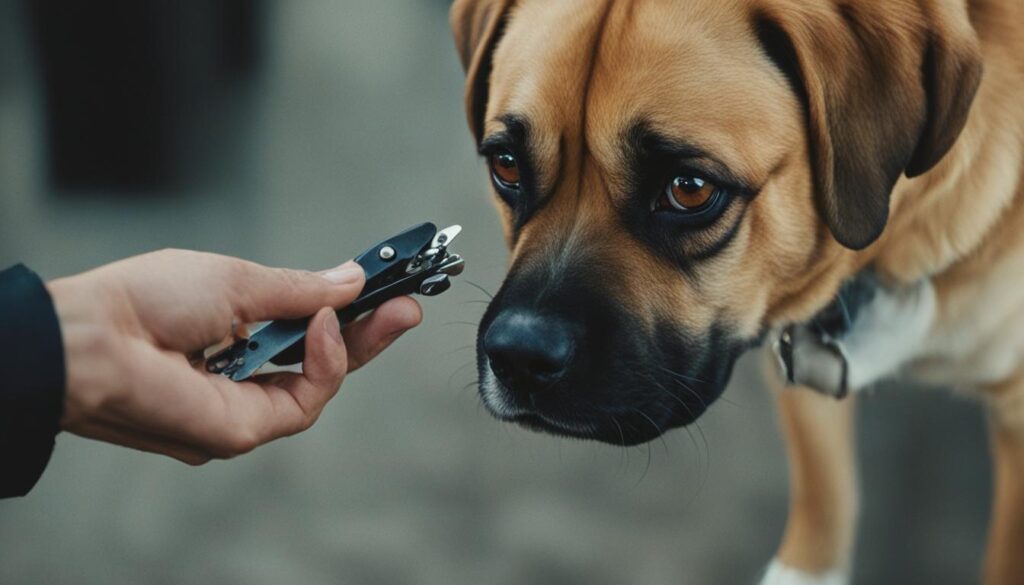
Getting your dog used to nail trimming is crucial for a smooth and stress-free experience. It’s essential to introduce the process gradually and positively acclimate your dog to the tools involved.
Start by gently touching your dog’s paws and gradually increase the contact over time. Use positive reinforcement techniques such as treats and praise to create a positive association with paw handling. This will help your dog feel more comfortable and trusting during nail trimming sessions.
Next, introduce the nail clippers to your dog. Allow them to sniff and examine the clippers to familiarize themselves with the tool. Offer rewards whenever the clippers are present to further reinforce positive associations.
For some dogs, it may be necessary to tap the nail with the clippers before actually cutting. This helps them become more accustomed to the sensation and reduces potential discomfort. Remember to offer treats and praise during this process as well.
It’s important to go at your dog’s pace and not force them into a full nail trimming session if they are not ready. Patience is key when introducing new experiences to your dog, and gradually building their confidence will lead to a more successful nail trimming routine in the long run.
Tips for Introducing Your Dog to Nail Trimming:
- Gently touch your dog’s paws to acclimate them to the sensation.
- Use positive reinforcement, such as treats and praise, to create a positive association with paw handling.
- Introduce the nail clippers and let your dog sniff and examine them.
- Offer rewards whenever the clippers are present to reinforce positive associations.
- Tap the nails with the clippers before cutting to help your dog become more comfortable.
- Go at your dog’s pace and don’t force them into a full nail trimming session if they aren’t ready.
| Benefits of Introducing Your Dog to Nail Trimming |
|---|
| Reduces fear and stress during nail trimming sessions |
| Makes future nail trimming sessions easier and more efficient |
| Promotes a positive relationship between you and your dog |
| Prevents injuries caused by resistance or fear during nail trims |
| Creates a safer and more enjoyable grooming experience overall |
By taking the time to introduce your dog to nail trimming and using positive reinforcement techniques, you can help them become more comfortable and cooperative during the process. This will make regular nail maintenance easier for both of you and contribute to your dog’s overall well-being.
Choosing the Right Tools for Black Dog Nail Trimming

When it comes to trimming black dog nails, having the right tools is crucial for a safe and stress-free experience. Using dog nail clippers specifically designed for dogs is essential, as human nail trimmers won’t be effective. One of the most user-friendly options is the scissor-style trimmers, which offer better visibility while cutting. Alternatively, you can opt for nail grinders that file down the nails instead of cutting them, providing a gentler approach.
There are various types of clippers available in the market, including guillotine-style and plier-style. The guillotine-style clippers have a hole where you insert the nail, and a blade slides forward to cut it. On the other hand, plier-style clippers resemble pliers – you squeeze the handles together to trim the nail.
When selecting the right dog nail trimmers, consider the size and thickness of your dog’s nails. Smaller dogs may require smaller clippers, while larger breeds with thicker nails may benefit from larger, more heavy-duty options. It’s always best to choose clippers that suit your dog’s specific needs for a comfortable and efficient trimming session.
Additionally, it’s important to have styptic powder on hand in case of accidental cuts and bleeding. Styptic powder aids in stopping bleeding quickly, providing peace of mind in case any mishaps occur during the nail trimming process.
Best Practices for Trimming Black Dog Nails
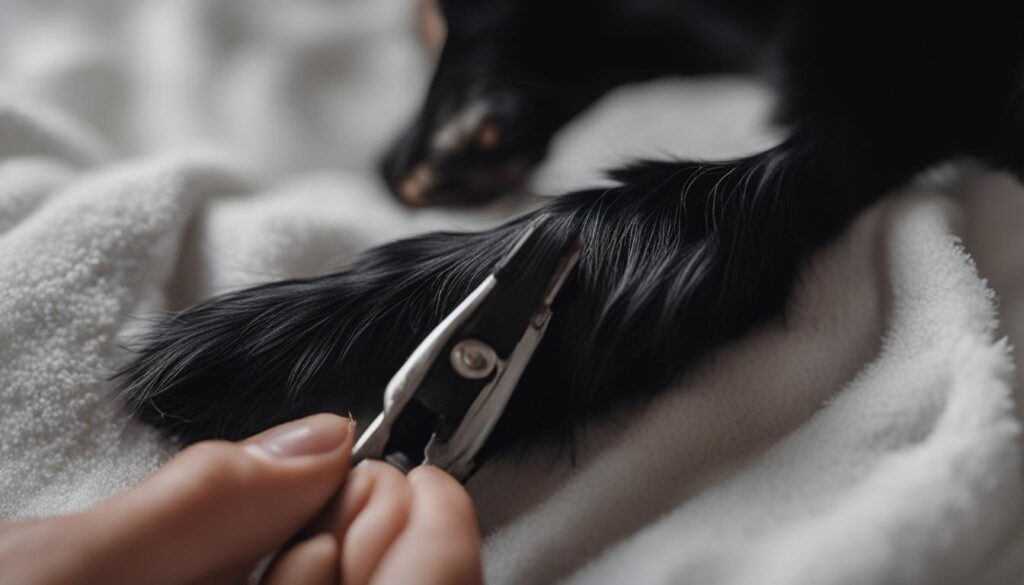
When it comes to trimming black dog nails, following the best practices will ensure a safe and successful session. Here are some tips to keep in mind:
- Begin by gently but firmly holding your dog’s paw. Use your thumb to press the pad and your forefinger to extend the nail, providing better visibility for the trimming process.
- Cut small increments at a time, approximately 1/16th of an inch. This gradual approach allows for more control and reduces the risk of cutting too close to the quick.
- Avoid applying side-to-side pressure while cutting. Instead, cut from top to bottom using smooth, steady motions.
- After each cut, check the color of the nail. If you see a whitish color, you can continue trimming. However, if you notice a black or pinkish color, that indicates you’re getting close to the quick and should stop to avoid injury.
- Take your time during the trimming process. Patience is key, as rushing can lead to accidents and unnecessary stress for your dog.
Following these best practices will help you effectively trim your black dog’s nails while ensuring their safety and comfort.
Overcoming the Challenges of Trimming Black Dog Nails

Trimming black dog nails can present some unique challenges, but with the right strategies and techniques, you can overcome these difficulties for a successful nail trimming session.
Take Breaks and Stay Calm
If your dog becomes stressed during the nail trimming process, it’s important to take breaks and continue at a later time. Allow your dog some time to relax and calm down before attempting to trim their nails again. Remember to stay calm and patient throughout the process, as your dog can sense your emotions.
Use Positive Reinforcement
Keeping your dog calm and cooperative is key to successful nail trimming. Use treats and positive reinforcement to create a positive association with the experience. Reward your dog with treats and praise during and after the trimming session to reinforce good behavior.
Trim Slowly and In Small Increments
When dealing with black nails, it can be difficult to determine the location of the quick, the sensitive part of the nail. To avoid cutting too close and causing bleeding, trim slowly and in small increments. This allows you to maintain control and avoid any accidental injuries.
Handle Accidental Bleeding
If you accidentally cut the quick and the nail starts bleeding, don’t panic. Apply styptic powder or corn starch to the affected area to stop the bleeding. These substances help promote clotting and prevent further bleeding. If the bleeding doesn’t stop or if you’re unsure about how to handle it, consult your veterinarian for guidance.
Seek Assistance if Needed
Having an extra pair of hands can be helpful during the nail trimming process, especially when dealing with black nails. Ask a family member or a friend to assist you in holding your dog’s paw and providing treats. This can make the process more manageable and less stressful for both you and your dog.
Successfully trimming black dog nails requires patience, attentiveness, and the right techniques. By using these tips and strategies, you can overcome the challenges associated with black nail trimming and ensure a safe and comfortable experience for your furry friend.
The Importance of Regular Nail Trimming
Regular nail trimming is crucial for the overall health and well-being of dogs. Overgrown nails can cause discomfort and pain, affect their posture, and even lead to more serious health issues. Keeping your dog’s nails at an appropriate length prevents them from catching on surfaces or breaking off, which can be painful and cause bleeding.
Regular trims also make it easier for dogs to walk and maintain proper balance. When nails are too long, it can alter the way a dog walks and puts unnecessary strain on their joints. By keeping their nails trimmed, you can help prevent these issues and ensure that your dog can move comfortably and without difficulty.
Additionally, regular nail trimming allows you to monitor your dog’s nail health. By regularly examining their nails, you can spot any abnormalities such as cracks, splits, or infections. Early detection of these issues can prevent them from worsening and requiring more extensive treatment.
It is recommended to trim your dog’s nails when you can hear them clicking on the floor. This is a good indicator that their nails have become too long and need to be trimmed. However, the frequency of nail trims may vary depending on your dog’s lifestyle and activity level. Dogs who spend a lot of time outdoors or participate in activities that naturally wear down their nails may require less frequent trims compared to dogs who are primarily indoors.
Regular nail trimming not only benefits your dog’s physical health but also contributes to their overall well-being. By maintaining proper nail care, you can prevent discomfort, pain, and potential health issues, allowing your dog to live a happier and more comfortable life.
Tips for a Successful Black Dog Nail Trimming Session
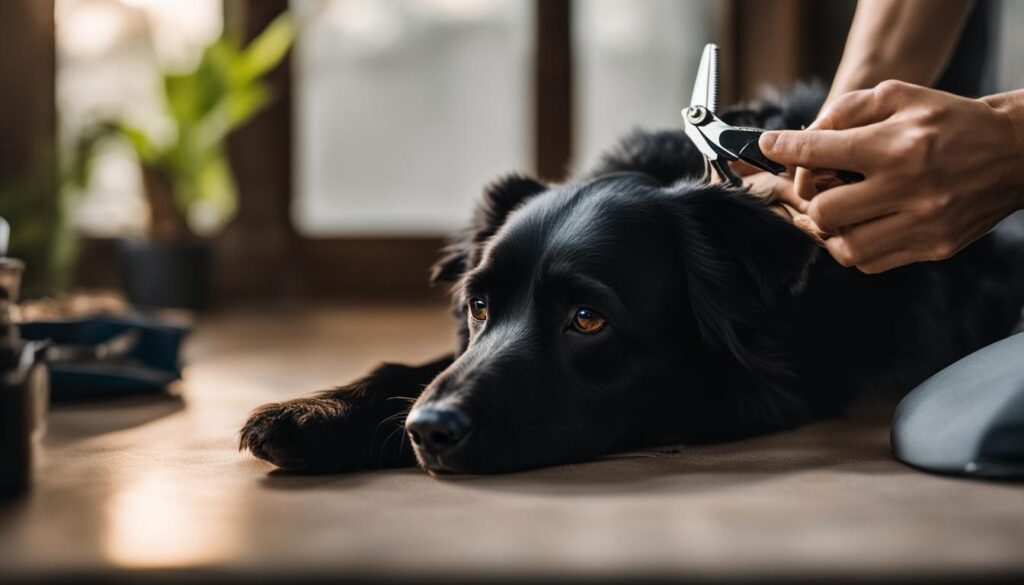
To ensure a successful black dog nail trimming session, follow these tips:
- Creating the Right Environment
Prepare a calm and quiet environment for the nail trimming session. Minimize distractions to keep your dog focused and relaxed. Find a comfortable and well-lit area with good visibility.
- Use Positive Reinforcement
Keep your dog calm and cooperative during the nail trimming process by using treats and positive reinforcement. Reward them for good behavior and provide reassurance throughout the session. This will help create a positive association with nail trimming.
- Choose the Appropriate Tools
Select the right nail trimmers for your dog’s size and nail thickness. Scissor-style trimmers are often recommended for better visibility and control. Consider using a nail grinder if your dog is more comfortable with filing instead of cutting. Have styptic powder or corn starch available to quickly stop any bleeding from accidental cuts.
- Take Breaks and Don’t Rush
Take breaks if needed during the nail trimming session. If your dog becomes stressed or uncomfortable, pause and resume later. It’s important not to rush the process to ensure a positive experience for both you and your dog.
- Trim in Small Increments
When trimming black nails, cut in small increments to avoid cutting too close to the quick. Check the color of the nail after each cut. If it appears whitish, you can continue trimming. If it appears black or pinkish, you’re getting close to the quick and should stop. Trim a little at a time and proceed with caution.
- Seek Professional Help if Unsure
If you are unsure about trimming your dog’s black nails or if your dog is particularly anxious or resistant, seek professional help or advice from a veterinarian or groomer. They can provide guidance and perform the nail trimming for you, ensuring it is done safely and successfully.
“Trimming your dog’s black nails can be challenging, but by creating a conducive environment, using positive reinforcement, selecting the right tools, taking breaks when necessary, trimming in small increments, and seeking professional help when needed, you can have a successful black dog nail trimming session.” – Professional Dog Groomer
Wrapping Up
Trimming black dog nails may seem daunting, but with the right tools, techniques, and patience, it can be done safely and successfully. As a responsible pet owner, it’s important to understand that regular nail trimming is essential for the health and well-being of your dog. By taking the time to acclimate your dog to paw handling and nail clippers, you can make the process more comfortable for them and enhance your bond.
Always proceed at your dog’s pace and be mindful of their comfort level. If you’re unsure or uncomfortable with trimming black nails, don’t hesitate to seek assistance from a professional groomer or veterinarian. They can provide guidance and help ensure that your dog’s nails are kept at an appropriate length.
Remember, practice makes perfect. With time, patience, and confidence, you’ll become proficient at cutting your dog’s black nails. Turn nail trimming sessions into positive and rewarding experiences by using treats and praise as positive reinforcement. By making nail trimming a regular part of your dog’s grooming routine, you’ll be taking an important step towards their overall health and well-being.
FAQ
How can I trim my dog’s black nails safely?
To trim your dog’s black nails safely, start by acclimating your dog to paw handling and nail clippers. Use positive reinforcement and take it slow. When cutting black nails, start with small increments and look for the appearance of the quick, a small black dot in the center of the white horn. Trim a little at a time and avoid cutting too close to the quick to prevent bleeding and pain.
Why is trimming black dog nails challenging?
Trimming black dog nails can be challenging because the quick, the sensitive part of the nail, is hidden and not easily visible. Unlike white nails, where the quick is pink and easy to spot, black nails require more caution and attention. Cutting the quick can be painful for the dog and lead to bleeding.
How can I introduce my dog to nail trimming?
To introduce your dog to nail trimming, start by gently touching their paws and gradually increase contact. Use positive reinforcement, such as treats and praise, to create a positive association. Introduce the nail clippers and let them sniff and examine them. Go at your dog’s pace and use treats to reward cooperation.
What tools should I use for black dog nail trimming?
For black dog nail trimming, use dog nail trimmers specifically designed for dogs. The scissor-style trimmers offer better visibility. Alternatively, nail grinders can be used to file down the nails. Choose the type of clippers that suit your dog’s size and nail thickness. Keep styptic powder on hand in case of accidental cuts and bleeding.
What are the best practices for trimming black dog nails?
When trimming black dog nails, it’s important to take it slow and proceed in small increments. Check the color of the nail after each cut to gauge how close you are to the quick. If you see a whitish color, you can continue trimming. If you see a black or pinkish color, you’re getting close to the quick and should stop. Trim from top to bottom and avoid using side-to-side pressure.
How can I overcome the challenges of trimming black dog nails?
To overcome the challenges of trimming black dog nails, take breaks if your dog becomes stressed and continue the trimming session later. Use treats and positive reinforcement to keep your dog calm and cooperative. Trim slowly and in small increments to avoid cutting too close to the quick. If you accidentally cut the quick and the nail starts bleeding, apply styptic powder or corn starch to stop the bleeding.
Why is regular nail trimming important for dogs?
Regular nail trimming is important for dogs because overgrown nails can cause discomfort, affect their posture, and lead to more serious health issues. Keeping your dog’s nails at an appropriate length prevents them from catching on surfaces or breaking off, which can be painful and cause bleeding. Regular trims also make it easier for dogs to walk and maintain proper balance.
What are some tips for a successful black dog nail trimming session?
For a successful black dog nail trimming session, create a calm and quiet environment to minimize distractions. Use treats and positive reinforcement to keep your dog calm and cooperative. Trim in a well-lit area for better visibility. Take breaks if needed and don’t rush the process. Use the appropriate nail trimmers for your dog’s size and nail thickness. Trim in small increments, checking the color of the nail after each cut. If uncertain, seek professional help or advice from a veterinarian or groomer.
What should I keep in mind when trimming black dog nails?
When trimming black dog nails, take your time, be patient, and don’t rush the process. It’s important to acclimate your dog to paw handling and nail clippers before attempting to trim their nails. Start with small increments and look for the appearance of the quick. Trim a little at a time and avoid cutting too close to the quick to prevent bleeding and pain. If unsure or uncomfortable with trimming black nails, consult a professional groomer or veterinarian for assistance.


